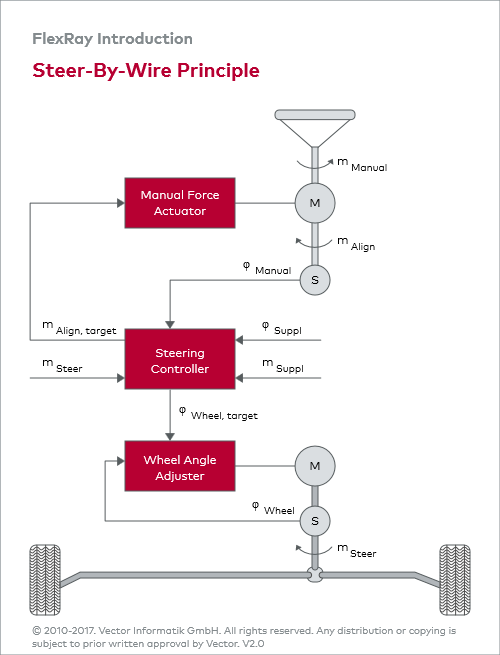Steer-by-wire
The steering systems of today’s motor vehicles are equipped with hydraulic, electro-hydraulic or electrical steering assist, depending on the steering forces required. Regardless of the type of steering assist, these systems retain a mechanical linkage between the steering wheel and the steered wheels, so that if the power assist fails, the mechanical linkage still exists.
In the electric steering system shown in the figure, the car driver’s steering input is accepted by an ECU via a control line, processed and transmitted via a control line as a control command to the actuator where it is put into motion. At the point of mechanical coupling, there is an actuator for positioning the wheels (wheel angle adjuster) and a motor for simulating the self-aligning forces fed back to the steering wheel (manual force actuator). Coordination between the manual force actuator and wheel angle adjuster is handled by the steering controller. The steering column is in a way replaced by communication lines, and the driver steers “by wire”.
Besides implementing variable steering assist and steering ratio — i.e. individual adjustment of the steering characteristic — the greatest potential of such systems based on the steer-by-wire principle lies in the incorporation of steering into vehicle dynamics control to increase active safety. As a logical extension of today’s ESP systems, ESP II opens up new dimensions of driving dynamics and driving stability with its active steering control functions.
Because a failure in steering means losing control of the vehicle, steering is of course a safety-critical system in the motor vehicle by definition. The elimination of the mechanical fallback level in these steering systems has intensified discussions about the reliability of safety-critical automotive electronic systems. On the path toward steer-by-wire systems, a number of complex tasks still needs to be worked out, above all with regard to fault tolerance.

